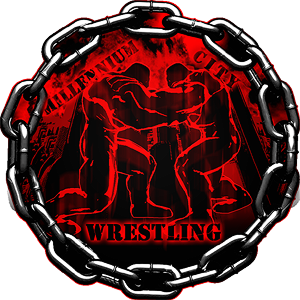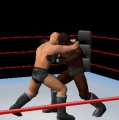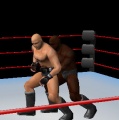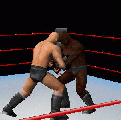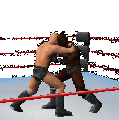Wrestling Club
| ||||||||||||||||||||
Contents
Public Information
The Wrestling Club was founded by registered Millennium City hero Bronx in an attempt to interact with other heroes interested in the sport. Initial advertising originally began through word-of-mouth, but there are now posters and pamphlets to be found in most Gyms across the city. These pamphlets contain information for getting in touch with Bronx, who will then provide details on when and where meetings will occur. The group currently has an active roster of several members, most of whom have their own particular reason for joining the club. It is important to note this is a recreational club, not a Super Group. There is no "joining" procedure, aside from regularly participating in group events.
Structure
The Wrestling Club most regularly meets at Bronx's flat, located on the western side of the Downtown district in Millennium City. A wrestling ring has been installed in Bronx's home gym, that allows for event matches and training in a private, friendly environment. Though Bronx is the designated leader of the group, and the one who regularly hosts meetings, the club is structured to allow open socialization. Wrestlers seeking competition, training partners, or friends with similar interests to hang out with, may all use the Wrestling Club as a resource for finding such persons. Though Event and Hosted matches have specific rules that must be followed, private matches between consenting wrestlers may employ whatever rules they desire.
Wrestler Weight Classes
- Cruiserweight
- Below 400 lbs (<181 kg)
- Heavyweight
- 400 - 800 lbs (182 - 362 kg)
- Super Heavyweight
- Above 800 lbs (363> kg)
Rules
These rules apply only to officially hosted meetings, training sessions, matches and events. Rules in regards to private matches are at the discretion of the wrestlers participating.
- Win by Pinfall or Submission
- 3 Count Rule, Rope-Breaks in effect.
- Limit Attacks and Striking to Torso Only
- To prevent excessive injury. No closed fists. Open palm strikes and chops only.
- No Blood
- To prevent excessive injury and maintain sanitary wrestling environment.
- Dirty Fighting Moves are Permitted (Limited)
- Claw holds, Scratches and Bites are permitted, so long as they don't draw blood. No Groin Attacks.
- No Sexual Conduct
- The Wrestling Club is open to members of any sexual preference. In order to maintain club neutrality and prohibit unwelcome behavior, no member should engage in sexual conduct whether by action or inference with other members.
Member Requirements
The requirements for joining are as follows:
- Members must have an interest in any form of Wrestling. This includes, but is not limited to, Freestyle, Amateur, American Professional, Lucha Libre and/or Sambo.
- Members must possess the physical capacity for Wrestling. All current Members are near peak-physical condition, and thus maintain competitive fairness when wrestling with other members. Weight Classes are based on meta-physical strength as well as weight, thus excluding anyone who is not physically capable of competing with at least a non-meta wrestler.
- Members must possess the capacity to recognize pain and avoid critically injuring other Members. Most wrestlers in the club are heroes, and are required to be in peak health and performance when on patrol. Therefore, certain attacks have been prohibited in the interest of reducing risk of injuries that may cause a hero to be unable to perform their heroic duties. It is also vital that wrestlers be able to recognize when to cease or submit during a match, so as not to seriously harm themselves or others.
Official Match Types
- One Versus One
- The most common match type, where two wrestlers compete against one another.
- One Versus Two (Handicap)
- One wrestler (either exceptionally skilled, or in a higher weight class) competes against Two wrestlers (either less skilled or in a lower weight class)
- Two Versus Two (Tornado)
- Two wrestlers face off against Two wrestlers, with all four wrestlers present in the ring, competing.
- Two Versus Two (Tag)
- Two wrestlers face off against Two wrestlers, with only Two wrestlers in the ring at a time. Wrestlers must tag their ally in by physical contact.
Match Conditions
- Kayfabe
- Wrestling is both competition and entertainment; Kayfabe is the introduction of additional entertainment value by creating stories surrounding the wrestling events, as well as introducing a developing character aspect, separate from the actual character themselves ("alter-ego", "in-ring mentality"). In order to accommodate wrestlers whose lives revolve around wrestling, in-ring Kayfabe is permitted and encouraged, but not a necessity.
- Selling
- In order to avoid injury, a wrestler may need to take a fall. This involves letting the opponent perform a successful wrestling move. Instead of resisting, the seller will purposefully position themselves to land as painlessly as possible. This has the benefit of extending a match, providing entertainment, and raising the moral of both wrestlers due to synergy in performing a move. Even if a member does not take part in the promotion of Kayfabe, it is important they recognize when it may be more dangerous trying to resist a move, than simply letting their opponent complete the move. Selling also refers to making certain moves carry more impact by over-reacting slightly, making the move seem more legitimate. This may be done to prevent Jobbing from taking place, as it maintains the skill balance between wrestlers, despite advantages one or the other may have.
- Jobbing
- Somewhat related to Kayfabe, Jobbing is where one wrestler has a clear and distinct advantage over the other, who is usually less experienced or of a much lower Weight Class. Though matches are generally arranged to be as fair as possible for both wrestlers, there may be matches arranged like this in order to ensure variety in the matches presented. Matches where there is no contest (where one wrestler is clearly going to win) are called Squash matches. A Jobber is likely to spend the majority of the match in a losing position, but may or may not make a comeback toward the end.
- Training
- Often taking place during regular meetings, training matches won't have their outcomes tracked. Regular matches can be converted to training matches if both wrestlers agree to the terms, thus preventing either of them from tracking a win or loss in their overall performance.
Member Resources
Wrestling Procedures
- RP Wrestling involves making attempts. If you don't make an attempt at something, it may be seen as directly influencing the other player's character. This is a valid function in certain situations, but may also be seen as God-Modding. Make sure that the opponent player is accommodating when you perform an action without making an attempt. If one player has made an attempt, and the opponent accepts it as successful, the opponent does not need to respond with an attempt, unless they perform an additional, separate action.
Simple Example:
- Proper Attempt: Red attempts to enter a collar-and-elbow lock-up with Blue! If successful, he'd attempt to trip Blue!
- Proper Response: Blue locks up with Red, but adjusts his stance, and avoids being tripped. Dropping the lockup, Blue tries to grapple Red in a headlock!
- Improper Attempt: Red locks up and trips Blue!
- Improper Response: Blue attempts to lock up and not be tripped, and grabs Red in a headlock.
- Knowledge is power! The more you yourself know about wrestling, the more proficient your character will be. Until extensive resources are provided on this page, use resources such as Wikipedia, Google, or even wrestling video games, to inform yourself about the moves and mechanics of wrestling. The more enlightened you are, the more detail you will be able to provide, and the more in-depth the match can become. With a wider array of wrestling knowledge, your response time will be better as well, decreasing the amount of time both you and your opponent have to wait between moves, and allowing for longer, more varied matches.
Wrestling Thesaurus
Here are words that may prove invaluable for adding variety to descriptions of moves, wrestlers, body parts or other valid mechanics.
Physical Descriptive Words
| Swole (large) | Swollen (muscular) | Column-like (large) |
| Trunk-like (large) | Thick (large) | Powerful (large/muscular) |
| Strong (large/muscular) | Muscular | Massive |
| Hard (tough) | Lean (muscular/vascular) | Ripped (muscular/vascular) |
| Vascular (veiny/ripped) | Mighty (large/muscular) | Brawny (large/muscular) |
| Burly (large) | Robust (strong) | Stout (thick/strong) |
| Sturdy (tough) | Rugged (tough) | Sinewy (vascular) |
| Herculean (massive) | Colossal (massive) | Gargantuan (massive) |
| Gigantic (massive) | Huge (massive) | Impressive (large) |
| Vigorous (tough) | Python-like (large/muscular) | Veiny (vascular) |
| Stocky (strong) | Rippling (muscular) | Striated (defined) |
Body Parts
| Supine (laying on back, face up) | Prone (laying on stomach, face down) | |
| Anterior (front) | Posterior (rear) | |
| Medial (closer to mid-line of body/moving in-ward) | Lateral (away from mid-line of body/moving outward) | |
| Extremities (legs/arms) | Limb (arm/legs/plural) | Upper Body |
| Upper Extremities (arms) | Lower Body | Lower Extremities (legs) |
| Head | Neck | Traps/Trapezius (Neck muscles between throat and shoulders) |
| Deltoids (shoulder muscles) | Shoulder | Clavical (Bones above chest, under neck, between shoulders) |
| Pecs/Pectorals (chest muscles) | Chest | Biceps (anterior upper arm muscle; used for pulling) |
| Triceps (posterior upper arm muscle; used for pushing) | Forearm/Wrist | Hands/Palms |
| Fingers/Digits | Abs/Abdominals/Abdomen (core muscles) | Obliques/"Sides" (muscles adjacent to abdominals) |
| Waist (center of mass) | Hip (center of mass) | Glutes (hip, posterior) |
| Thigh (upper leg) | Femur (upper leg, posterior) | Patella (kneecap, anterior) |
| Calf (lower leg, posterior) | Ankle | Foot |
| Toes/Digits |
Actions Descriptive Words
| Grapple | Lock-up (grapple) | Confront (melee) | Combat (melee) |
| Engage (approach/melee) | Attack (approach/melee) | Lunge (approach) | Catch (grapple/melee) |
| Clash (grapple/melee) | Clasp (grapple/hold) | Clutch (grapple/hold) | Clinch (grapple/hold) |
| Fasten (grapple/hold) | Grasp (grapple/hold) | Grip (hold) | Hold |
| Hook (hold) | Hug (grapple/hold) | Seize (grapple/hold) | Tackle (lunge) |
| Tussle (grapple) | Struggle (grapple) | Escape | Avoid (dodge) |
| Dodge | Evade | Elude | Parry (block) |
| Lift | Press | Push | Shove |
| Slam | Smash | Blow | Crash |
| Whack | Wham | Smack | Slap |
| Chop | Pound | Squeeze | |
| Crush |
RP Wrestling Terms (RP Wrestling Mechanics)
| Attempt (attempts an attack) | Try (tries an attack) |
| Undertake (undertakes attacking) | Strive (strives to pin) |
| Endeavor (endeavors to apply a pin) | Effort (makes an effort to attack) |
| Work (works to achieve a pin) | Would (use to reference a (usually successful) conclusion to an attempt already being performed: <X> tries to tackle, and would attempt a pin) |
Wrestling Moves
Wrestling Moves Database
Click Here to view the Wrestling Moves Database
Basic Stances, Grapples and Lock-Ups:
Roll System
Turn System
Wrestling Matches are essentially turn-based, with each wrestler performing a Move. Moves are either Attacking Moves (attacking/pinning/applying submission holds), or Reaction Moves (dodging/taking a fall/getting hit). Generally, once a match has started, a player's turn will consist of both a Reaction and then an Action, as the player is Reacting to the opponent's Action, and then performing an Action of their own (which the opponent will React to, and then perform an Action against, etcetera).
- Action Moves are generally aggressive moves against the opponent, intending to reduce the opponent's Endurance Points.
- Reaction Moves are generally defensive moves, used to Evade, Counter, Block, Resist or Escape the opponent's Action Move.
- Passive Moves are a unique move that isn't an Action or Reaction, necessarily. Passive moves include moving to a different location in the ring, climbing a turnbuckle or rope, appealing to the crowd, taunting, or otherwise. Passive Moves count as a turn, however.
All players begin with a set number of Endurance Points, determined by the wrestlers preceding the match. The recommended Endurance Point value for a normal length match is 10. The recommended Endurance Point value for a short match is 7.
When a wrestler has no more endurance points remaining, they forfeit the match, and the opponent is declared the winner. The losing player may Roleplay their wrestler submitting, or being rendered temporarily unconscious, as the Roleplay dictates.
Roll System
Wrestlers can use a roll-based system in order to ensure a non-biased wrestling match. A recommended resource is Rolz Dice Rooms, a chat room system designed for Roleplaying that features dice rolling mechanics, in which a wrestling roleplay can take place. For the Roll System, the following terms will be used:
- Attacker: The player performing an attack.
- Victim: The player being attacked.
When the Attacker performs an attack, the Victim performs a Roll in order to determine whether the Attacker's move Critically Hits, Succeeds, Fails, or Critically Fails. Determining pass or fail is done using a Roll min/max of 1 - 50, with certain ranges providing certain effects:
- 1 - 10, Critical Fail: The Victim does not pass the roll check, and is unable to perform an Action Move against the Attacker. The Attacker is given a second turn to continue the move, begin a new move, or gain an extra count in a Pin. The Victim loses 2 Endurance Points.
- 11 - 24, Fail: The Victim does not pass the roll check, and loses 1 Endurance Point. It is then the Victim's turn.
- 25 - 39, Success: The Victim passes the roll check, and is able to Evade, Counter, Block, Resist or Escape the Attackers move. The Victim does not take any damage, and it becomes the Victim's turn.
- 40 - 50, Critical Success: The Victim passes the roll check, and is able to Evade, Counter, Block, Resist or Escape the Attacker's move. The Victim instantly damages and decreases the Attacker's Endurance Points by 1. It then becomes the Victim's turn.
Struggle: If the Attacker's move was a successful Grapple or Submission, the Victim struggles to escape. During a struggle, the Attacker performs a roll to determine whether the Submission remains in-effect:
- If Attacker's roll is a Critical Fail, the Attacker loses 1 Endurance Point, the Victim is released, and it becomes the Victim's turn.
- If Attacker's roll is a Fail, the Victim is released, and it becomes the Victim's turn.
- If Attacker's roll is a Success, the Victim looses 1 Endurance Point, and it becomes the Victim's turn to attempt another escape.
- If Attacker's roll is a Critical Success, the Victim looses two endurance points, and it becomes the Victim's turn to attempt another escape.
Using the roll system, the players will perform their turn as normal, though the outcome must reflect the results determined by the roll. If a Victim's defense roll fails, the Victim must subtract the determined number of Endurance Points from their current total, and provide a response that addresses the success of the Attacker's move. If the Victim's defense roll succeeds, the Victim must address how they avoided the Attacker's move (generally by Evading, Countering, Blocking, Resisting or Escaping).
In a Struggle (Grappling or Submission move), the following order is performed:
- Step 1: The Attacker performs a Grapple or Submission move that is a Success.
- Step 2: The Victim describes taking the hit, and begins struggling to Escape.
- Step 3: The Attacker rolls to determine whether the Grapple or Submission remains in effect.
- - If Attacker's roll is a Success, the Victim describes taking the hit, and resumes struggling to Escape. The Attacker rolls to determine if the Grapple or Submission continues (return to Step 1).
- - If Attacker's roll is a Fail, the Attacker describes the success of the Victim's escape, and it becomes the Victim's turn.
Trait System
Wrestlers can select one Trait that influences their base Stats. These are used in order to lend some further customization to a wrestler, as well as take into consideration certain innate abilities wrestlers might have based on their size, weight, species, experience, etcetera. It is up to the wrestlers involved, to decide whether Traits will be permitted in a match, or whether both wrestlers should retain equal stats. Base Traits are listed below:
By Size (Height):
- Small: Available to Wrestlers less than 300 lbs (136 kg). Shorter in stature than most offers a higher chance of escaping, or directing an attack with critical success. If opponent is not Small: Instead of 40 - 50 Critical Success range, use 35 - 50 Critical Success range, however, you have -2 less Maximum Endurance Points.
- Average: Average height offers no real loss of mobility, or overwhelming strength.
- Large: Available to Wrestlers more than 600 lbs (272 kg). A greater size gives greater advantage in grappling. Instead of 25 - 39 Success range, use 20 - 39 Success range.
- Giant: Available to Wrestlers more than 800 lbs (362 kg). Huge and potentially unwieldy gives a profound advantage in grappling smaller opponents. If opponent is not Giant: Instead of 25 - 39 Success range, use 20 - 35 Success range.
By Ability:
- Super Agility: Being quicker than most offers a higher chance of Critical Success against slower opponents. If opponent is not Super Agile: Instead of 40 - 50 Critical Success range, use 35 - 50.
- Super Endurance: To be tougher means to last longer than your opponent. +5 Endurance Points to Maximum Endurance Points. Instead of 40 - 50 Critical Success range, use 43 - 50 Critical Success range, and gain +1 Endurance point on a Critical Success.
- Super Strength: Through superior physical strength, dominating opponents is effortless. +3 Endurance Points to Maximum Endurance Points. If opponent is not Super Strong: When the opponent Fails, they lose 2 Endurance points instead of 1. If the opponent Critically Fails, they lose 3 Endurance points instead of 2.
- Martial Training: Seeking balance of mind and body grants normal stats, but a powerful ability: You are given 3 Martial Counters to instantly reverse an opponent's attack against you. A Martial Counter is a unique move, performed when rolling for defense against an Attacker's move. A Martial Counter is treated as a Critical Success against the opponent, instantly decreasing the opponent's Endurance Points by 1. A Martial Counter may be used in conjunction with another move, in the same turn.
By Personality:
- Determined: A tough mind lends to a tough body. Willpower alone provides +5 Maximum Endurance Points.
- Dominating: When the opponent is in your hands, they become nearly powerless to escape. When performing a Struggle roll that determines whether a Submission or Grapple remains in effect, Instead of 25 - 39 Success range, use 20 - 35 range (does not apply to Pins).
- Jobber: Feeling it's your role to place the other wrestler in a positive light makes the opening of a match a challenge. -4 Endurance Points to Maximum Endurance Points, but gain +1 Endurance point on a Critical Success.
- Face (Hero): You are the good guy of the match! +3 Endurance Points to Maximum Endurance Points, Instead of 1 - 10 Critical Fail range, use 1 - 7 Critical Fail range, and Instead of 40 - 50 Critical Success range, use 36 - 50 Critical Success range.
- Heel (Villain): You are the bad guy of the match, capable of slipping in low blows. +5 Endurance Points to Maximum Endurance Points, Instead of 1 - 10 Fail range, use 1 - 7 Critical Fail range, and Instead of 25 - 39 Success range, use 28 - 35 Success range.
- Legend: Whether by Fame or Infamy, you are a well-recognized champion in the eyes of others. +7 Endurance Points to Maximum Endurance Points, Instead of 25 - 39 Success range, use 22 - 37. You will never Critically Fail (Critical Fail rolls become a Fail roll).
